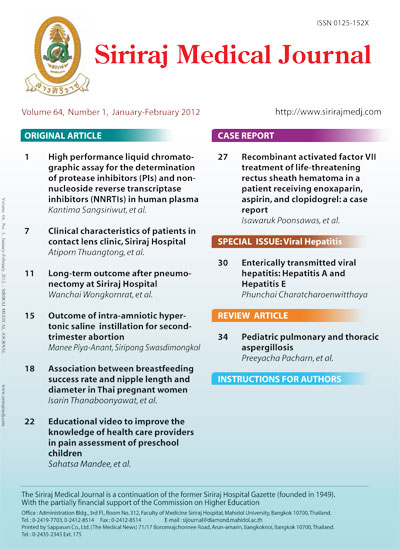Quality of Life and Hemoglobin Levels of Hemodialysis Patient at Siriraj Hospital
Keywords:
Quality of life; hemoglobin; kidney disease quality of life - short form; erythropoietinAbstract
Objective: To evaluate the relationship of the quality of life (QOL), and hemoglobin (Hb) level of hemodialysis (HD) patients.
Methods: This study was a cross-sectional study. Face-to-face interviews using a Kidney Disease Quality of Life - Short
Form (KDQOL-SF™1.3) questionnaire (which consisted of SF-36 and kidney disease questionnaires) were conducted during
November-December 2009 with 152 patients receiving hemodialysis at Siriraj hospital, Bangkok, Thailand. QOL measures were
compared in stepwise Hb levels of ≤9, >9 to 10, >10 to 11, >11 to 12, and >12 g/dl. Scores of QOL and Hb level were
examined for the relationship and statistical significance by using ANOVA.
Results: The increasing Hb levels are statistically significant increases in kidney disease domain scores on the kidney disease
component of the questionnaire (p=0.042). About the SF36 component, the difference between 5 groups of Hb levels were
significant in the general health (p=0.023), role emotion (p=0.015), social functioning (p=0.008), and mental component summary
scores (p=0.039).
Conclusion: The difference of the Hb levels were statistically significant differences in the effects of kidney disease, general
health, role emotion, and social function scores, and mental component summary scores of the KDQOL-SF questionnaire.
However, a long-term assessment should be considered. These findings have implications for the care of hemodialysis patients
in terms of the initiation of the Hb target of erythropoietin (EPO) therapy.
References
with chronic renal insufficiency among adults in the United States: results
from the Third National Health and Nutrition Examination Survey. J Am
Soc Nephrol. 2002 Feb;13(2):504-10.
2. Levin NW. Quality of life and hematocrit level. Am J Kidney Dis. 1992
Jul;20(1Suppl 1):16.
3. Levin N, Lazarus J, Nissenson A. National Cooperative rHu Erythropoietin
Study in patients with chronic renal failure--an interim report. The National
Cooperative rHu Erythropoietin Study Group. Am J Kidney Dis. 1993
Aug;22(Suppl 1):3.
4. Drueke TB, Locatelli F, Clyne N, Eckardt KU, Macdougall IC, Tsakiris D,
et al. Normalization of hemoglobin level in patients with chronic kidney
disease and anemia. N Engl J Med. 2006 Nov;355(20):2071-84.
5. Phrommintikul A, Haas SJ, Elsik M, et al. Mortality and target haemoข-
globin concentrations in anaemic patients with chronic kidney disease
treated with erythropoietin: a meta-analysis. Lancet. 2007 Feb;369:381-8.
6. Besarab A, Bolton WK, Browne JK, Egrie JC, Nissenson AR, Okamoto
DM, et al. The effects of normal as compared with low hematocrit values
in patients with cardiac disease who are receiving hemodialysis and
epoetin. N Engl J Med. 1998 Aug 27;339(9):584-90.
7. Singh A, Szczech L, Tang K, Barnhart H, Sapp S, Wolfson M. Correction
of anemia with epoetin alfa in chronic kidney disease. N Engl J
Med. 2006 Nov 16;355(20):2085-98.
16
8. Fishbane S, Nissenson AR. The new FDA label for erythropoietin treatment:
how does it affect hemoglobin target? Kidney Int. 2007 Oct;72(7):
806-13.
9. Canadian Erythropoietin Study Group. Association between recombinant
human erythropoietin and quality of life and exercise capacity of patients
receiving haemodialysis. Canadian Erythropoietin Study Group. BMJ.
1990 Mar;300(6724):573-8.
10. Foley R. Erythropoietin: physiology and molecular mechanisms. Heart
Fail Rev. 2008 Dec;13(4):405-14.
11. Hays R, Kallich J, Mapes D, Coons S, Amin N. Kidney Disease Quality
of Life Short Form (KDQOL-SFtm) In: Carter W, editors. A Manual
for Use and Scoring; 1997. p. 1-43.
12. Towse A, Mills A, Tangcharoensathien V. Learning from Thailand’s
health reforms. BMJ. 2004 Jan 10;328(7431):103-5.
13. McMahon LP, Mason K, Skinner SL, Burge CM, Grigg LE, Becker GJ.
Effects of haemoglobin normalization on quality of life and cardiovascular
parameters in end-stage renal failure. Nephrol Dial Transplant. 2000
Sep;15(9):1425-30.
14. Lefebvre P VF, Sarokham B, Enny C, Provenzano R, Cremieux PY.
Relationship between hemoglobin level and quality of life in anemic
patients with chronic kidney disease receiving epoetin alfa. Curr Med
Res Opin. 2006 Oct;22:1929-37.
15. Provenzano R G-ML, Suchinda P, von Hartitzsch B, Woollen SB, Zabaneh
R, Fink JC. Once-weekly epoetin alfa for treating the anemia of chronic
kidney disease. Clin Nephrol. 2004 Jun;61:392-405.
16. Revicki DA BR, Feeny DH, Henry D, Teehan BP, Rudnick MR, Benz
RL. Health-related quality of life associated with recombinant human
erythropoietin therapy for predialysis chronic renal disease patients. Am
J Kidney Dis. 1995 Apr;25:548-54.
Downloads
Published
How to Cite
Issue
Section
License
Authors who publish with this journal agree to the following conditions:
Copyright Transfer
In submitting a manuscript, the authors acknowledge that the work will become the copyrighted property of Siriraj Medical Journal upon publication.
License
Articles are licensed under a Creative Commons Attribution-NonCommercial-NoDerivatives 4.0 International License (CC BY-NC-ND 4.0). This license allows for the sharing of the work for non-commercial purposes with proper attribution to the authors and the journal. However, it does not permit modifications or the creation of derivative works.
Sharing and Access
Authors are encouraged to share their article on their personal or institutional websites and through other non-commercial platforms. Doing so can increase readership and citations.











